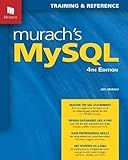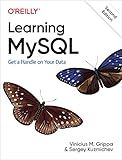Best MySQL Transaction Guides to Buy in January 2026

MySQL Crash Course: A Hands-on Introduction to Database Development



Murach's MySQL (4th Edition) Professional SQL Book & Reference Guide with Cheat Sheets - Complete Database Development Training for Retrieving, Updating & Managing Data with AWS Integration



PHP & MySQL: Server-side Web Development



Murach's MySQL



SQL: Learn SQL (using MySQL) in One Day and Learn It Well. SQL for Beginners with Hands-on Project. (Learn Coding Fast with Hands-On Project Book 5)



Front-End Back-End Development with HTML, CSS, JavaScript, jQuery, PHP, and MySQL



Learning PHP, MySQL & JavaScript: A Step-by-Step Guide to Creating Dynamic Websites



Learning MySQL: Get a Handle on Your Data



High Performance MySQL: Optimization, Backups, Replication, and More
- AFFORDABLE PRICES FOR QUALITY SECONDHAND READS.
- THOROUGHLY INSPECTED FOR MINIMAL WEAR AND TEAR.
- ENVIRONMENTALLY FRIENDLY CHOICE-REDUCE, REUSE, READ!



MySQL Cookbook: Solutions for Database Developers and Administrators


Performing transactions in MySQL involves executing a group of SQL statements as a single unit, ensuring that all statements within the transaction are executed successfully, or none are executed at all. This ensures database integrity and consistency.
To perform transactions in MySQL, you need to follow these steps:
- Begin the transaction by using the START TRANSACTION statement or simply by explicitly initiating the transaction with BEGIN.
- Execute the desired SQL statements within the transaction block, such as INSERT, UPDATE, or DELETE statements. These statements can manipulate data in one or multiple tables.
- If any of the statements encounter an error, you can choose to either rollback the entire transaction or handle the error and proceed accordingly.
- In case of an error or if you decide to cancel the transaction explicitly, rollback the transaction using the ROLLBACK statement. This will undo all the changes made within the transaction.
- If everything within the transaction executes successfully and you want to permanently save the changes, commit the transaction using the COMMIT statement. This will make all the changes permanent and durable.
It's important to note that by default, MySQL implicitly commits each statement as a separate transaction if explicit transaction control statements (START TRANSACTION, COMMIT, ROLLBACK) are not used. Therefore, if you want to ensure a series of statements are handled as a single logical unit, you should wrap them within a transaction block explicitly.
By using transactions, you can maintain data consistency, prevent data corruption, and control the durability of database changes in MySQL.
How to perform a case-insensitive search in MySQL?
To perform a case-insensitive search in MySQL, you can use either the LIKE operator with the ILIKE or REGEXP operators, or you can modify the collation of the column being searched.
- Using LIKE and ILIKE:
- LIKE is the pattern matching operator in MySQL.
- ILIKE is a case-insensitive version of LIKE that can be used if your MySQL version does not support it natively.
- Here's an example of using LIKE with a case-insensitive search: SELECT * FROM table_name WHERE column_name LIKE '%search_term%' COLLATE utf8_general_ci; In this example, table_name is the name of the table you're searching and column_name is the name of the column you're searching in. search_term is the term you're searching for. The COLLATE utf8_general_ci clause specifies a case-insensitive collation for the search.
- Using REGEXP:
- REGEXP is a regular expression matching operator in MySQL.
- Use the REGEXP operator with the BINARY keyword to perform a case-insensitive search.
- Here's an example: SELECT * FROM table_name WHERE column_name REGEXP BINARY 'search_term'; In this example, table_name is the name of the table you're searching and column_name is the name of the column you're searching in. search_term is the term you're searching for.
- Modifying the collation:
- You can modify the collation of the column to be case-insensitive permanently. However, this approach can affect other queries and may require additional precautions.
- Here's an example of altering the collation of a column to be case-insensitive: ALTER TABLE table_name MODIFY column_name VARCHAR(x) COLLATE utf8_general_ci; In this example, table_name is the name of the table containing the column, column_name is the name of the column to be altered, and x represents the original length of the column.
Note that the exact syntax and capabilities may vary based on your MySQL version.
What is the difference between DELETE and TRUNCATE in MySQL?
DELETE and TRUNCATE are both SQL commands used to remove data from a table in MySQL, but there are some key differences between them:
- DELETE:
- DELETE is a DML (Data Manipulation Language) command used to delete specific rows from a table.
- It can be used with a WHERE clause to specify the conditions of the rows to be deleted.
- DELETE command is slower as it logs individual row deletions and takes care of maintaining the referential integrity (triggers and constraints).
- The data deleted by DELETE can be rolled back (if the transaction is not committed yet) and the operation can be undone.
- The auto-incremented value of the deleted rows is not reset.
- TRUNCATE:
- TRUNCATE is a DDL (Data Definition Language) command used to delete all rows from a table.
- It does not have a WHERE clause, so it removes all the data from the table.
- TRUNCATE command is faster as it removes data in a single operation, without logging individual row deletions.
- It also resets the auto-incremented value of the table to its initial starting point.
- TRUNCATE cannot be rolled back, as it is considered a non-logged operation.
- Since it is a DDL command, it requires the DROP privilege rather than the DELETE privilege.
In summary, DELETE is typically used when specific rows need to be deleted, offering more control and allowing for a transaction rollback, while TRUNCATE is used to quickly remove all rows from a table, resetting the auto-incremented value, and not being able to be rolled back.
How to change the data type of a column in MySQL?
To change the data type of a column in MySQL, you can use the ALTER TABLE statement. Here's an example of how you can do it:
- Connect to your MySQL database using a client or a terminal.
- Select the database in which the table you want to modify resides. USE your_database_name;
- Use the ALTER TABLE statement to change the data type of the column. Specify the table name, the column name, and the new data type. ALTER TABLE your_table_name MODIFY COLUMN your_column_name new_data_type; For example, if you want to change the data type of a column named "age" in a table named "users" to INT: ALTER TABLE users MODIFY COLUMN age INT; Note: Depending on the data type you need to change to, you may also need to specify other attributes such as size or precision.
- Commit the changes. COMMIT;
Please note that altering the data type of a column may result in data loss or unexpected behavior if the new data type is not compatible with the existing data in the column. It is important to backup your data before making such changes.
How to calculate the average value of a column in MySQL?
To calculate the average value of a column in MySQL, you can use the AVG() function. Here's an example:
- Connect to your MySQL database.
- Use the following query to calculate the average value of a specific column (e.g., "column_name") from a table (e.g., "table_name"):
SELECT AVG(column_name) FROM table_name;
Make sure to replace "column_name" with the actual name of the column you want to calculate the average for, and "table_name" with the actual name of the table.
- Execute the query, and you will get the average value of the column as the result.
How to delete a database in MySQL?
To delete a database in MySQL, you can follow these steps:
- Open the MySQL command-line tool or a suitable MySQL client.
- Login into your MySQL server with appropriate credentials (username and password) that have the necessary privileges to delete a database.
- Use the following command to delete the database:
DROP DATABASE database_name;
Replace database_name with the name of the database you want to delete.
- Press Enter to execute the command.
You will see a message confirming that the database has been dropped successfully.
What is the purpose of the WHERE clause in MySQL?
The WHERE clause in MySQL is used to filter the result set of a SELECT statement based on the specified condition. It allows you to specify one or multiple conditions that a row must meet to be included in the result set. By using the WHERE clause, you can retrieve specific rows from a table that meet your desired criteria. This conditions can involve comparisons between columns, expressions, or values, and can be combined using logical operators such as AND, OR, and NOT.
